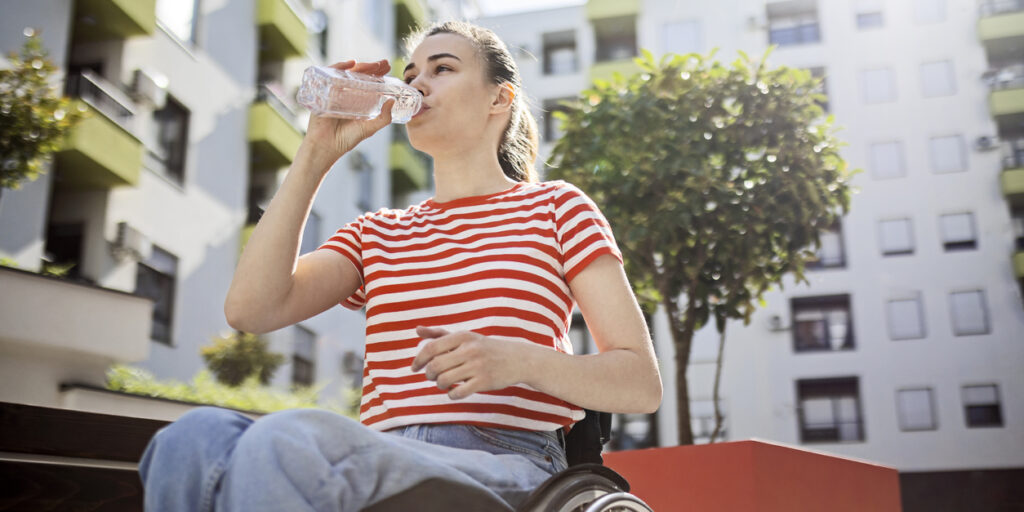
Hydration for Wheelchair Users
By Cheryl Alkon | Thursday, June 29, 2023
We all need water for our bodies to function well. But people who use wheelchairs or have other mobility issues often limit liquids so they can avoid restrooms

Rachel T. Rose, MOT, OTR/L is an occupational therapist who works with people with neuromuscular diseases.
while away from home or between caregiver shifts. Unfortunately, this can cause dehydration, which can lead to other health problems.
“We’ve all heard that you could survive weeks without food but only days without water,” says Rachel T. Rose, MOT, OTR/L, Senior Occupational Therapist at University of Iowa Health Care. “This is because water is a crucial life force and impacts every cell in our body.”
According to the National Academies of Sciences, Engineering, and Medicine, men should get about 15.5 cups of fluids (via food and liquid) each day, while women should take in about 11.5 cups daily. The National Council on Aging suggests eight daily cups of water, though you can determine a more specific guideline by converting one-third of your body weight into daily ounces (i.e., a 150-pound person should drink 50 ounces of water a day).
The importance of good hydration

Julia Yasek, RN, FNP-BC, DNP, is a nurse practitioner who works with people with ALS.
Photo credit: Columbia University Irving Medical Center
“Being properly hydrated benefits every single organ and function in your body,” says Julia Yasek, RN, FNP-BC, DNP, a nurse practitioner at the Eleanor and Lou Gehrig ALS Clinic at Columbia University. The benefits range from bowel regularity to better airway clearance and cognitive function.
On the flip side, not having enough water can lead to:
- Constipation
- Headaches
- Stiff joints
- Heat intolerance
- Irritability, fatigue, or lack of focus
With prolonged dehydration, “our cells lose their ability to function, which may lead to further disease, urinary tract infection, or organ malfunction,” Rachel says.
Signs of dehydration include:
- Thirst
- Apple juice-colored urine. Normal urine should be pale yellow.
- Dry skin or eyes
- Weakness or dizziness
- Fatigue
- Changes in vital signs, such as low blood pressure or an increased heart rate
Can you skip liquids?
The average person urinates between six and seven times a day, according to the Cleveland Clinic. People with mobility issues may want to limit their trips to the restroom. But is it safe to do so?
Rachel educates her patients about fluid shifting, the idea of adjusting the timeframe of drinking liquids so frequent bathroom visits aren’t needed during a time when you know you won’t have easy access.
“This is a good discussion to have with your care team to identify your specific goals for pausing fluid intake,” she says. “The goal is to find the best time to shift your fluids so you can do the things you need to do as seamlessly as possible, yet still ensure you’re staying hydrated.”
The best way to hydrate
Water — either from the tap or purified — is best for daily hydration since it has no calories or added sugars. Consider adding lemon, lime, orange, cucumber, or mint for flavor if it makes it easier to drink more water.
High-water foods, such as melons, oranges, zucchini, cucumber, lettuce, and soups will help supplement daily hydration but shouldn’t be the main water source, according to Rachel. For some people with neuromuscular diseases, simply eating can use up a lot of energy, and foods such as melons and cucumbers aren’t nutritionally dense, so it’s best to speak with a dietitian if this is a concern.
If you have diabetes or swallowing issues, working with a dietician, nutritionist, or speech and language pathologist can help identify the healthiest hydration options for you.
Alcohol and high-caffeine beverages, such as coffee, some teas, and energy drinks, “can draw out water from the body and are not recommended for optimal hydration,” Rachel says. She and Julia urge moderation. “If you are going to enjoy your morning coffee or midday tea, consider drinking a cup of water first, or have a drink of water every couple of sips,” Rachel suggests.
Find the right equipment
Ask your occupational therapist or healthcare team about equipment options for your wheelchair that can help with hydration. “Your OT can help set up a system, configure the mounting position, and educate your caregivers or family members,” she says.
Options may include:
- An armrest cup holder (swiveling or stationary) with a lightweight mug or hook handle mug for easy reach and grasp
- A cup holder on a flexible arm that allows you to position the cup or bottle
- A water bottle with a long drinking straw, such as Giraffe Bottle or Hydrant
- Water reservoirs or backpacks that attach to the back of a wheelchair, such as Camelbak
Tips for good hydration habits
If you need help making sure you drink enough water, try these tips:
- Drink one or two glasses of water first thing in the morning.
- Use a water bottle with liquid volume markings to help you track how much you drink, or a smart water bottle that reminds you when to drink.
- Set alarms on your phone to remind you to drink. Make the alarm a favorite song for added motivation.
- Download an app such as Water Reminder or Waterllama.
“Learn and review the benefits of good hydration habits and how they positively impact your daily life,” Rachel says. “Understanding the direct effects good hydration and optimal fluid intake has on your body, well-being, and quality of life can help anchor the habit for the long haul.”
Next Steps and Useful Resources
- Get answers to common nutrition questions in the Quest article The Truth About Nutrition and Neuromuscular Disease.
- Watch the Nutrition and Neuromuscular Disease MDA Engage webinar to learn more about healthy eating.
- Stay up-to-date on Quest content! Subscribe to Quest Magazine and Newsletter.
Disclaimer: No content on this site should ever be used as a substitute for direct medical advice from your doctor or other qualified clinician.




